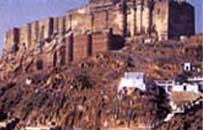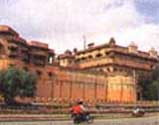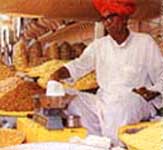|
Rajasthan has long been synonymous with camels,
sand dunes and colourfully dressed people. A
lot of people are pleasantly surprised when
they visit the state and find so much greenery
the lush green hills and deep valley, the lake
palaces and gardens. If you are wondering just
where the desert lies, welcome to Marwar. This
is your desert land. Come and see as much sand
as you want, ride camels and be fascinated by
the colourful costumes of the inhabitants. Jodhpur
can be your starting point popularly called
the sun city, Jodhpur gives the impression of
being a rugged no nonsense city that has little
time for the decorative and the pretty. Take
a Look at Mehrangrah Fort.
|
|
One of the most impressive and formidable structure that
looks down from a height of 125m. The solid walls with tiny
openings appear so daunting that it is easy to imagine the
dread with which the enemies must have viewed it. That is
how the fort appears from the outside. but when you're inside
its as if you've entered into a different world altogether.
Magnificent palaces with marvelloulsy carved panels and
latticed windows like the Moti Mahal, Phool Mahal, Sheesh
Mahal and the Daulat Khana. Spend a lot of time in the museum,
one of the best in Rajasthan, and see the fabulous collection
of Jodhpur royalty Palanquins, funiture, miniature paintings,
musical insturments and
|
costumes.Barmer
is famous for its carved wooden furniture and hand
block printing industry. This area is best visited
to gain an insight into the desert life and admire
the decorative skills of the simple village folk.
Undaunted by the harsh, unfriendly climate. The villagers
have some of the most beautiful mud huts that are
decorated with delicate folk motifs. The neat huts
|

Mehrangarh
Fort
|
are
a wonderufl backdrop for the colourtully dressed men and women.Try
and visit Barmer when it is festival time, the Tilwara cattle
fair is a good time to be here. Don't make the mistake of
thinking that if you've visited one desert city you've seen
them all. Desert cities are not all alike. A visit to Jaisalmer
will make you realise just how different each desert city
can be. No matter what you may have heard about this golden
city, nothing can quite prepare you for the sheer magic and
poetry of this brilliant city. infact, at what ever time of
the day you look at the Sonar Kila or Golden fort it looks
like a fairy tale creation.
|

Junagarh
Fort
|
History
recorded the fact that the Bhati Rajputs of Jaisalmer
lived of the forced levis on the great caravans
that crossed there area enroute to Delhi or central
India.Caravans, laden with precious cargo of spices
and silk brought wealth to this town. In the past
getting to Jaislmer was not easy. Its remote
|
location kept it safe from external influences, very few invading
armies had the courage to cross the harsh desert to attack
Jaislmer. Even during the British Raj Jaisalmer was the last
to sign the Agreement with the British.The remote citadel
is today famous for its carved havelies, its narrow streets
and its well preserved Jain temples. The small market located
just outside the fort is the main hub of activity, you can
pick up a large varity of local crafts here and explore the
streets on foot.
|
In fact the streets do seem like a walker's dream
no traffic no crowds and clean lanes. Just follow
your instincts and you will have covered the entire
town on foot. If you can pull yourself away from the
charm of the carved havelies then the other place
than you can see are Gadsisar lake, Ludarva, Aakal
and the royal centophs at Bada Bagh. For a closer
look at the sand dunes, get somebody to
|

Spicy
Galore
|
take you for a Camel ride on the dunes and gear yourself
up for an unforgetable experience of watching the sunset
over the desert. This lonely area comes alive at the time
of the desert festival every spring. Some more desert life
awaits you at Bikaner. This city lies on the northern point
of the triangle of the desert cities. A city that goes back
over 500 years when it was founded by one of the Princes
of Jodhpur clan. One rather interesting element about the
history of these desert cities is that they are located
on the major trade routes that connected Central Asia and
North India with the Gujarat Ports.
|
This is true of Bikaner as well as like most
of the other cities of the desert region, Bikaner
has been able to keep its medival flavour alive.
Water has been limited here so the customary
water palaces and pleasure gardens are missing.
The Ganga Golden Jubilee museum here has a vast
collection of rare exhibits covering almost
every period of Indian history. When in Bikaner
don't miss the famous temple of Karni Mata at
Deshnok, it is a beautiful temple where the
humble rats are also venerated, Gajner for lovers
of wildlife, and Kolayat, an ancient pilgrimage
centre. Visitors will love the camel wool products
of this region. Carpets, Durries, carved wooden
furniture, stone carving and block printing
are popular items to pick up from here. Other
desert crafts like leather work, basket weaving
and pottery are intresting.
|
|
|


